Mingyang Wang
Lost in Multilinguality: Dissecting Cross-lingual Factual Inconsistency in Transformer Language Models
Apr 05, 2025Abstract:Multilingual language models (MLMs) store factual knowledge across languages but often struggle to provide consistent responses to semantically equivalent prompts in different languages. While previous studies point out this cross-lingual inconsistency issue, the underlying causes remain unexplored. In this work, we use mechanistic interpretability methods to investigate cross-lingual inconsistencies in MLMs. We find that MLMs encode knowledge in a language-independent concept space through most layers, and only transition to language-specific spaces in the final layers. Failures during the language transition often result in incorrect predictions in the target language, even when the answers are correct in other languages. To mitigate this inconsistency issue, we propose a linear shortcut method that bypasses computations in the final layers, enhancing both prediction accuracy and cross-lingual consistency. Our findings shed light on the internal mechanisms of MLMs and provide a lightweight, effective strategy for producing more consistent factual outputs.
Growing a Twig to Accelerate Large Vision-Language Models
Mar 18, 2025Abstract:Large vision-language models (VLMs) have demonstrated remarkable capabilities in open-world multimodal understanding, yet their high computational overheads pose great challenges for practical deployment. Some recent works have proposed methods to accelerate VLMs by pruning redundant visual tokens guided by the attention maps of VLM's early layers. Despite the success of these token pruning methods, they still suffer from two major shortcomings: (i) considerable accuracy drop due to insensitive attention signals in early layers, and (ii) limited speedup when generating long responses (e.g., 30 tokens). To address the limitations above, we present TwigVLM -- a simple and general architecture by growing a lightweight twig upon an early layer of the base VLM. Compared with most existing VLM acceleration methods purely based on visual token pruning, our TwigVLM not only achieves better accuracy retention by employing a twig-guided token pruning (TTP) strategy, but also yields higher generation speed by utilizing a self-speculative decoding (SSD) strategy. Taking LLaVA-1.5-7B as the base VLM, experimental results show that TwigVLM preserves 96% of the original performance after pruning 88.9% of visual tokens and achieves 154% speedup in generating long responses, delivering significantly better performance in terms of both accuracy and speed over the state-of-the-art VLM acceleration methods. Code will be made publicly available.
On Relation-Specific Neurons in Large Language Models
Feb 24, 2025Abstract:In large language models (LLMs), certain neurons can store distinct pieces of knowledge learned during pretraining. While knowledge typically appears as a combination of relations and entities, it remains unclear whether some neurons focus on a relation itself -- independent of any entity. We hypothesize such neurons detect a relation in the input text and guide generation involving such a relation. To investigate this, we study the Llama-2 family on a chosen set of relations with a statistics-based method. Our experiments demonstrate the existence of relation-specific neurons. We measure the effect of selectively deactivating candidate neurons specific to relation $r$ on the LLM's ability to handle (1) facts whose relation is $r$ and (2) facts whose relation is a different relation $r' \neq r$. With respect to their capacity for encoding relation information, we give evidence for the following three properties of relation-specific neurons. $\textbf{(i) Neuron cumulativity.}$ The neurons for $r$ present a cumulative effect so that deactivating a larger portion of them results in the degradation of more facts in $r$. $\textbf{(ii) Neuron versatility.}$ Neurons can be shared across multiple closely related as well as less related relations. Some relation neurons transfer across languages. $\textbf{(iii) Neuron interference.}$ Deactivating neurons specific to one relation can improve LLM generation performance for facts of other relations. We will make our code publicly available at https://github.com/cisnlp/relation-specific-neurons.
Bring Your Own Knowledge: A Survey of Methods for LLM Knowledge Expansion
Feb 18, 2025Abstract:Adapting large language models (LLMs) to new and diverse knowledge is essential for their lasting effectiveness in real-world applications. This survey provides an overview of state-of-the-art methods for expanding the knowledge of LLMs, focusing on integrating various knowledge types, including factual information, domain expertise, language proficiency, and user preferences. We explore techniques, such as continual learning, model editing, and retrieval-based explicit adaptation, while discussing challenges like knowledge consistency and scalability. Designed as a guide for researchers and practitioners, this survey sheds light on opportunities for advancing LLMs as adaptable and robust knowledge systems.
Gnothi Seauton: Empowering Faithful Self-Interpretability in Black-Box Models
Oct 29, 2024Abstract:The debate between self-interpretable models and post-hoc explanations for black-box models is central to Explainable AI (XAI). Self-interpretable models, such as concept-based networks, offer insights by connecting decisions to human-understandable concepts but often struggle with performance and scalability. Conversely, post-hoc methods like Shapley values, while theoretically robust, are computationally expensive and resource-intensive. To bridge the gap between these two lines of research, we propose a novel method that combines their strengths, providing theoretically guaranteed self-interpretability for black-box models without compromising prediction accuracy. Specifically, we introduce a parameter-efficient pipeline, *AutoGnothi*, which integrates a small side network into the black-box model, allowing it to generate Shapley value explanations without changing the original network parameters. This side-tuning approach significantly reduces memory, training, and inference costs, outperforming traditional parameter-efficient methods, where full fine-tuning serves as the optimal baseline. *AutoGnothi* enables the black-box model to predict and explain its predictions with minimal overhead. Extensive experiments show that *AutoGnothi* offers accurate explanations for both vision and language tasks, delivering superior computational efficiency with comparable interpretability.
Better Call SAUL: Fluent and Consistent Language Model Editing with Generation Regularization
Oct 03, 2024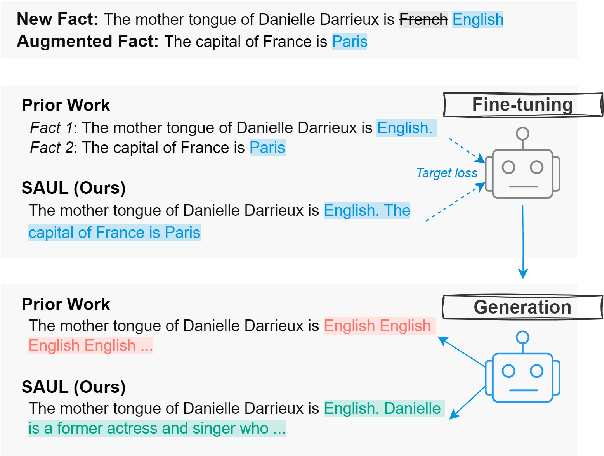
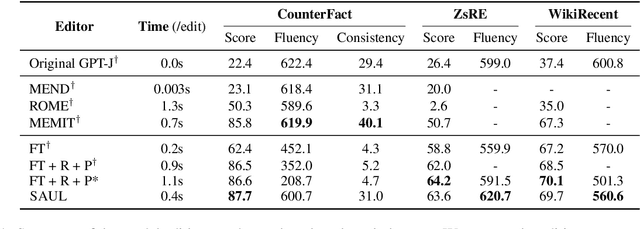
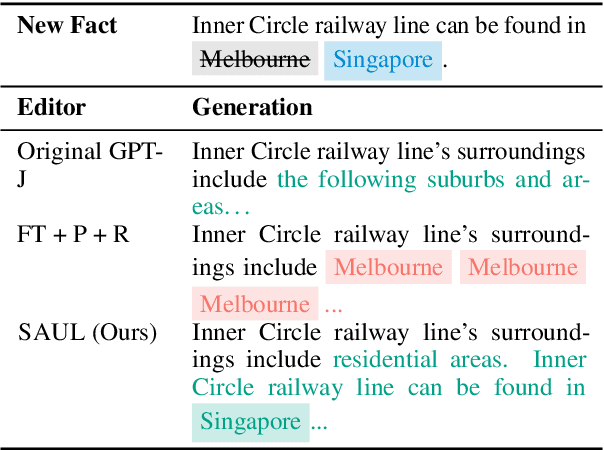
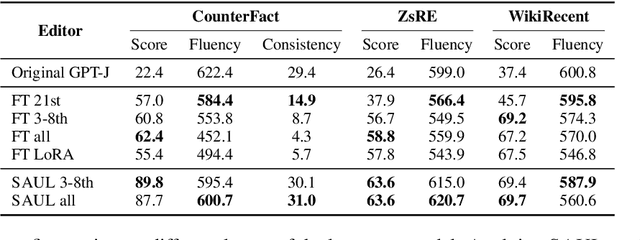
Abstract:To ensure large language models contain up-to-date knowledge, they need to be updated regularly. However, model editing is challenging as it might also affect knowledge that is unrelated to the new data. State-of-the-art methods identify parameters associated with specific knowledge and then modify them via direct weight updates. However, these locate-and-edit methods suffer from heavy computational overhead and lack theoretical validation. In contrast, directly fine-tuning the model on requested edits affects the model's behavior on unrelated knowledge, and significantly damages the model's generation fluency and consistency. To address these challenges, we propose SAUL, a streamlined model editing method that uses sentence concatenation with augmented random facts for generation regularization. Evaluations on three model editing benchmarks show that SAUL is a practical and reliable solution for model editing outperforming state-of-the-art methods while maintaining generation quality and reducing computational overhead.
LangSAMP: Language-Script Aware Multilingual Pretraining
Sep 26, 2024Abstract:Recent multilingual pretrained language models (mPLMs) often avoid using language embeddings -- learnable vectors assigned to different languages. These embeddings are discarded for two main reasons: (1) mPLMs are expected to have a single, unified parameter set across all languages, and (2) they need to function seamlessly as universal text encoders without requiring language IDs as input. However, this removal increases the burden on token embeddings to encode all language-specific information, which may hinder the model's ability to produce more language-neutral representations. To address this challenge, we propose Language-Script Aware Multilingual Pretraining (LangSAMP), a method that incorporates both language and script embeddings to enhance representation learning while maintaining a simple architecture. Specifically, we integrate these embeddings into the output of the transformer blocks before passing the final representations to the language modeling head for prediction. We apply LangSAMP to the continual pretraining of XLM-R on a highly multilingual corpus covering more than 500 languages. The resulting model consistently outperforms the baseline. Extensive analysis further shows that language/script embeddings encode language/script-specific information, which improves the selection of source languages for crosslingual transfer. We make our code and models publicly available at \url{https://github.com/cisnlp/LangSAMP}.
How Transliterations Improve Crosslingual Alignment
Sep 25, 2024



Abstract:Recent studies have shown that post-aligning multilingual pretrained language models (mPLMs) using alignment objectives on both original and transliterated data can improve crosslingual alignment. This improvement further leads to better crosslingual transfer performance. However, it remains unclear how and why a better crosslingual alignment is achieved, as this technique only involves transliterations, and does not use any parallel data. This paper attempts to explicitly evaluate the crosslingual alignment and identify the key elements in transliteration-based approaches that contribute to better performance. For this, we train multiple models under varying setups for two pairs of related languages: (1) Polish and Ukrainian and (2) Hindi and Urdu. To assess alignment, we define four types of similarities based on sentence representations. Our experiments show that adding transliterations alone improves the overall similarities, even for random sentence pairs. With the help of auxiliary alignment objectives, especially the contrastive objective, the model learns to distinguish matched from random pairs, leading to better alignments. However, we also show that better alignment does not always yield better downstream performance, suggesting that further research is needed to clarify the connection between alignment and performance.
Token-Mol 1.0: Tokenized drug design with large language model
Jul 10, 2024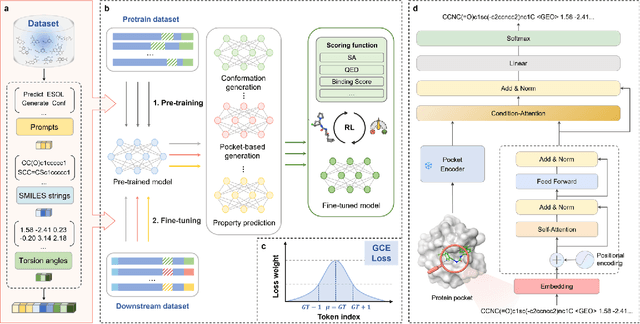

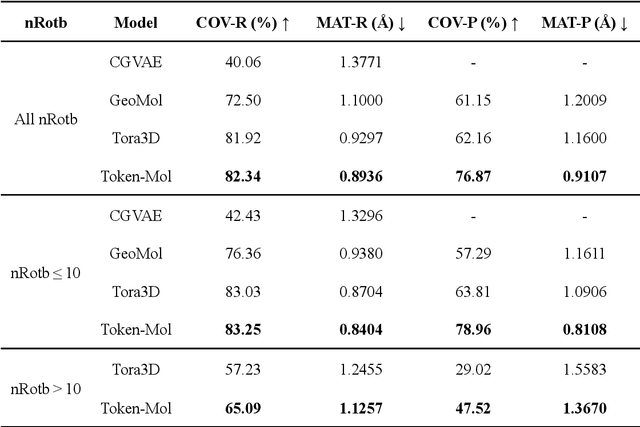
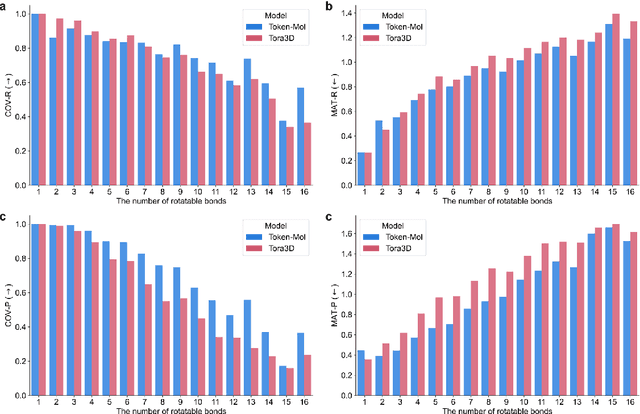
Abstract:Significant interests have recently risen in leveraging sequence-based large language models (LLMs) for drug design. However, most current applications of LLMs in drug discovery lack the ability to comprehend three-dimensional (3D) structures, thereby limiting their effectiveness in tasks that explicitly involve molecular conformations. In this study, we introduced Token-Mol, a token-only 3D drug design model. This model encodes all molecular information, including 2D and 3D structures, as well as molecular property data, into tokens, which transforms classification and regression tasks in drug discovery into probabilistic prediction problems, thereby enabling learning through a unified paradigm. Token-Mol is built on the transformer decoder architecture and trained using random causal masking techniques. Additionally, we proposed the Gaussian cross-entropy (GCE) loss function to overcome the challenges in regression tasks, significantly enhancing the capacity of LLMs to learn continuous numerical values. Through a combination of fine-tuning and reinforcement learning (RL), Token-Mol achieves performance comparable to or surpassing existing task-specific methods across various downstream tasks, including pocket-based molecular generation, conformation generation, and molecular property prediction. Compared to existing molecular pre-trained models, Token-Mol exhibits superior proficiency in handling a wider range of downstream tasks essential for drug design. Notably, our approach improves regression task accuracy by approximately 30% compared to similar token-only methods. Token-Mol overcomes the precision limitations of token-only models and has the potential to integrate seamlessly with general models such as ChatGPT, paving the way for the development of a universal artificial intelligence drug design model that facilitates rapid and high-quality drug design by experts.
Learn it or Leave it: Module Composition and Pruning for Continual Learning
Jun 26, 2024

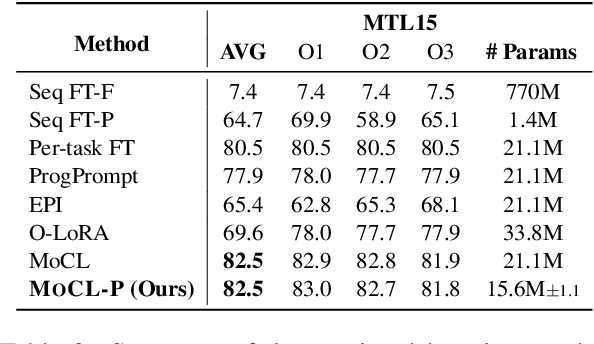
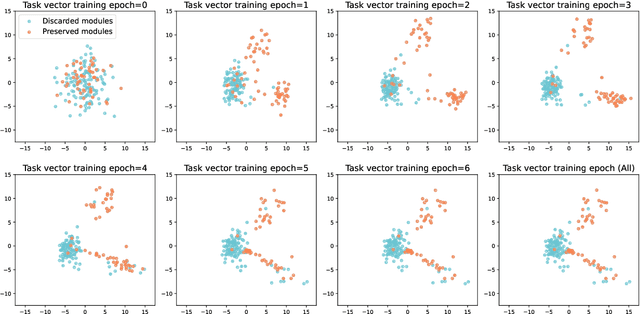
Abstract:In real-world environments, continual learning is essential for machine learning models, as they need to acquire new knowledge incrementally without forgetting what they have already learned. While pretrained language models have shown impressive capabilities on various static tasks, applying them to continual learning poses significant challenges, including avoiding catastrophic forgetting, facilitating knowledge transfer, and maintaining parameter efficiency. In this paper, we introduce MoCL-P, a novel lightweight continual learning method that addresses these challenges simultaneously. Unlike traditional approaches that continuously expand parameters for newly arriving tasks, MoCL-P integrates task representation-guided module composition with adaptive pruning, effectively balancing knowledge integration and computational overhead. Our evaluation across three continual learning benchmarks with up to 176 tasks shows that MoCL-P achieves state-of-the-art performance and improves parameter efficiency by up to three times, demonstrating its potential for practical applications where resource requirements are constrained.
 Add to Chrome
Add to Chrome Add to Firefox
Add to Firefox Add to Edge
Add to Edge